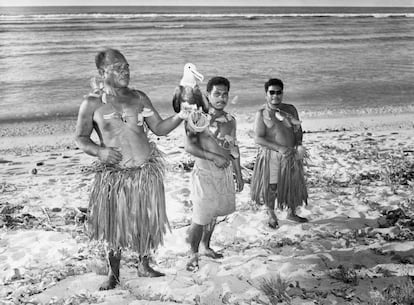How the island of Nauru became the fattest country in the world
A territory represents a way of living and eating; the interruption of that balance can put an end to a legacy of centuries

Before international law, dress codes or states existed, communities obtained their food from the environment in which they lived. Austere diets, sustained over millennia by hunter-gatherers, which gradually transitioned towards increasingly settled societies, thanks to the domestication of certain plants and animals. Undoubtedly, where there are crops, a productive rhythm is maintained. Studies on the matter establish that those first farmers noticed a greater growth of their plantations in the areas of accumulation of feces, where the animals were concentrated.
For thousands of years, the predominant source of fertilization was manure, until in 1804 the polymath Alexander von Humboldt came across some guano samples that, when analyzed, revealed an exceptional nitrogen, phosphorus and potassium content, which made it a highly effective fertilizer. In 1845, the intensive exploitation of the clusters and mountains shaped by the depositions that colonies of seabirds had accumulated over the centuries on some remote islands in the Pacific began. An amazing source of wealth, fueled by a strong demand for guano from Europe and the United States, in the midst of the agricultural revolution.
Surviving late 19th and early 20th century images of Nauruan natives show scenes of slender, medium-sized men. The women have long, curly hair, their upper bodies exposed and, like the men, wear pandanus fiber skirts. In the blink of an eye, the inhabitants of this atoll saw the exploitation of their phosphate deposits gradually devour the integrity of their universe – and their own. Finally, in 1968 they gained independence from Australia and took control of the mines, depleted after 70 years of producing wealth.
For the next two decades, the Nauruan government persisted with the exploitation of phosphate deposits, briefly placing its tiny republic of 11,000 citizens at the top of the ranking of the highest per capita incomes of the world – at the cost of depleting their resources. In addition to the terrain, the acculturation process undermined the culture of a people who embraced the Western lifestyle and diet. Two decades of wealth that changed the margins of their island for those of a consumer society: an airline, communications, imports of industrial food, alcohol, automobiles, electrical appliances and televisions that encouraged a sedentary lifestyle, all under the umbrella of a government that abolished taxes and unemployment and paid for the health and education of all the inhabitants. The good life, for life.
In the 1990s, after the spell of opulence had worn off, Nauru was a desolate wasteland in the middle of nowhere. In less than a century they went from a restrictive diet based on seafood, aquaculture from the Buada lagoon and tubers and fruits such as pandanus, to canned spam and corned beef. From simple preparations cooked in banana leaves, fish broths with coconut milk and fruit – to which the genetics of the Nauruans was adapted – to fried eggs and chicken with rice.
This deterioration in eating habits, together with a lack of exercise, earned Nauru a new title: the fattest country in the world. Today, 94% of its population is overweight and diabetes affects 66% of people aged 55. This story makes us reflect on the human ability to expel ourselves from the paradises we inhabit. On how we manage to destroy beautiful, safe places, with enough resources to live in harmony – just like we damage our bodies and minds with notions of development that are just the opposite of it. Is that what we really want?
Sign up for our weekly newsletter to get more English-language news coverage from EL PAÍS USA Edition










































